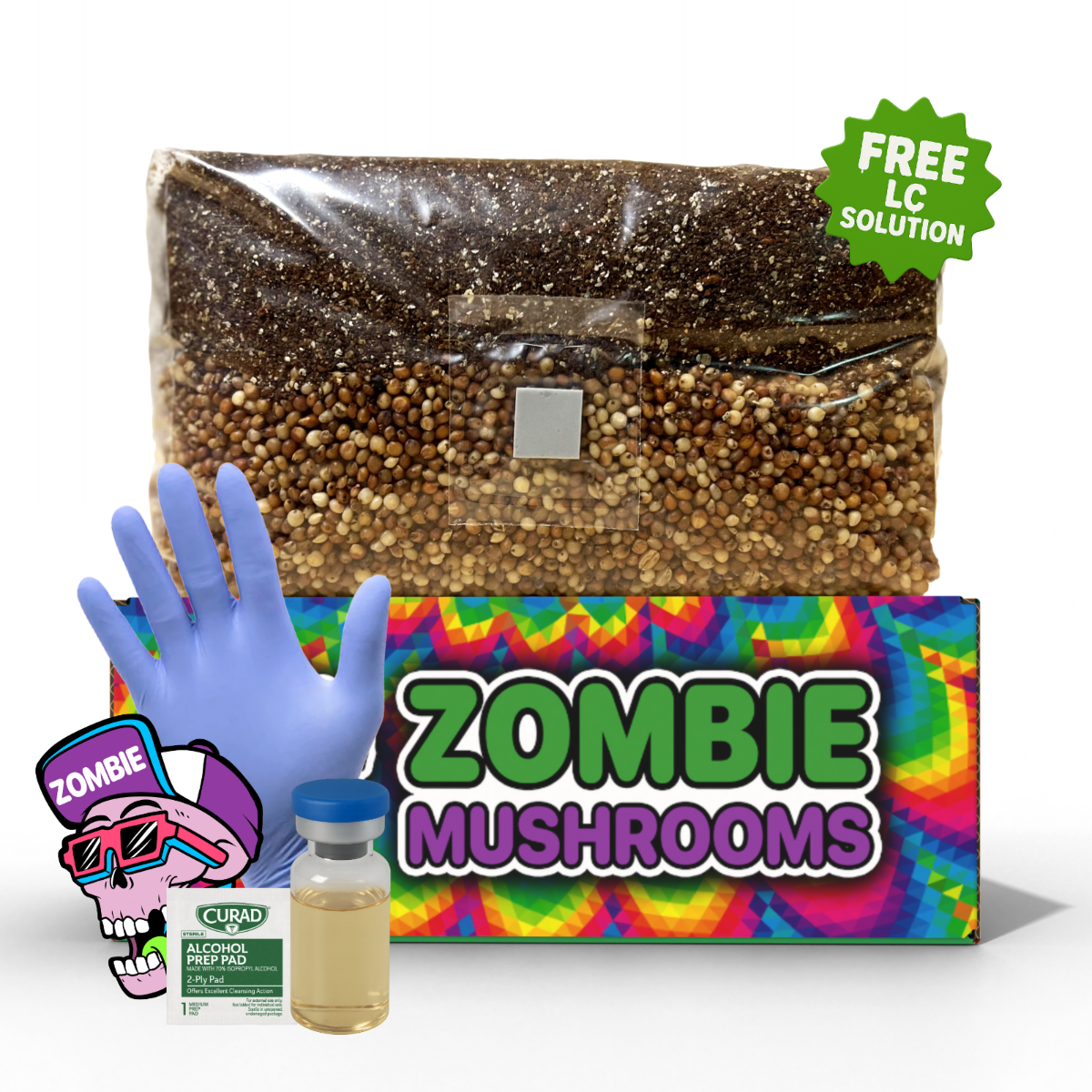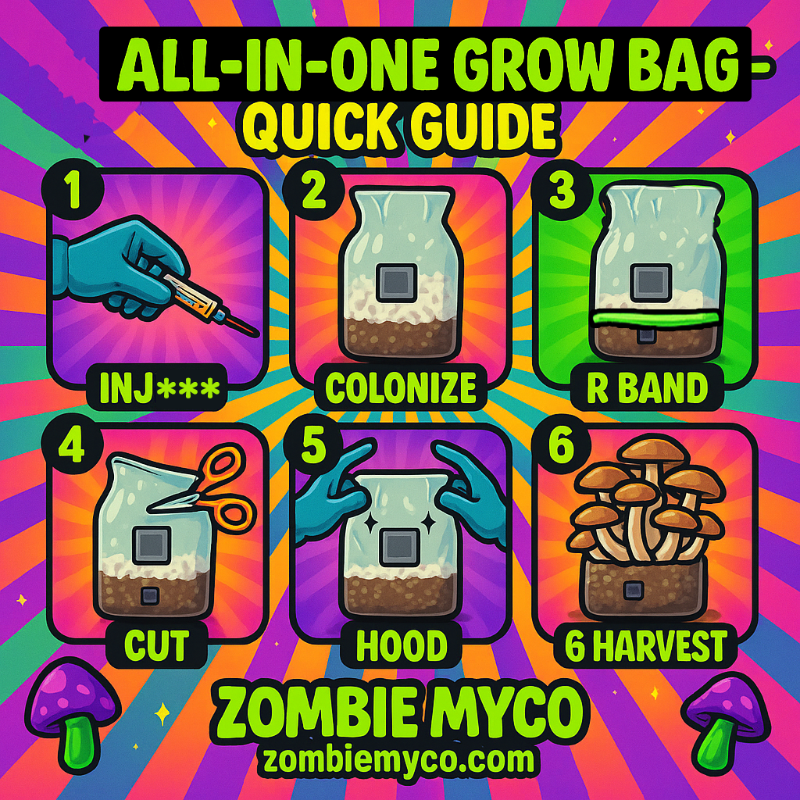⬇️ Prefer to listen instead? ⬇️
- Substrate choice can increase mushroom yield by 20–50%, especially with enriched blends like Master’s Mix.
- Adding 20% soy hulls to hardwood sawdust can increase mushroom yield by up to 300% (Royse, 2010).
- High-yield mushrooms do best with a substrate C:N ratio of 30:1–40:1.
- Coffee grounds are nutrient-rich but have high contamination risks if not sterilized.
- Straw combined with wheat bran provides up to 50% more yield than straw alone.
- Incorrect substrate pairing and prep are major causes of contamination and yield failure.
Mushroom cultivation success begins with one critical factor: choosing the right substrate. The substrate is the nutritional base for mushroom growth, impacting everything from colonization speed and fruiting size to contamination resistance and total yield. As a grower, selecting and preparing the best mushroom substrate recipe for your target species is the most effective approach you can use to cultivate high yield mushrooms. Materials like coco coir bricks are popular choices, and our Masters Mix substrate, made from hardwood pellets and soy hulls, comes pre-sterilized and hydrated so you can focus on growing, not prepping.

What Is Mushroom Substrate?
Mushroom substrate is the material created to support the life cycle of fungi by giving them needed nutrients, structural support, and proper moisture amounts. Unlike vascular plants that get nutrients through soil and photosynthesis, mushrooms depend totally on organic matter breakdown. This means a good substrate must copy the nutrient profile and conditions of the natural settings where fungi usually do well.
Substrates have a double function: they are both the food source and the growth medium. They hold the complex carbohydrates (like cellulose, hemicellulose, and lignin), needed minerals, and sometimes nitrogen-rich additions (such as soy hulls or bran) that power enzymatic reactions and support quick mycelium spread.
In their natural places, different species colonize specific habitats—hardwoods, leaf litter, animal dung, or straw—which shows that substrate selection is not a single solution for all. Some mushrooms are generalists and can grow on a variety of substrates, while others need very specific mixes to fruit well.

Why Is Choosing the Right Mushroom Substrate Important?
When it comes to cultivating mushrooms, using the appropriate substrate recipe doesn’t just affect growth—it decides success or failure. A compatible, high-quality mushroom substrate directly affects
- Biological Efficiency (BE): That’s the measure of pounds of mushrooms produced per pound of dry substrate. The right substrate leads to higher BE percentages.
- Contamination Risk: Species-specific substrates lower contamination since they are best for mushroom mycelium but less ideal for competitors.
- Colonization Speed: Good substrate choices result in faster colonization, reducing the chance for contamination and speeding up harvest cycles.
- Fruiting Performance: The number of flushes, fruiting body size, and even taste can change depending on substrate quality and compatibility.
In summary, whether you're a beginner with a grow kit or a small-scale commercial operator, tailoring substrates to specific mushroom species is the base of growing high yield mushrooms consistently.

Types of Mushroom Substrates (Best-Performing Materials)
Mushroom substrates are in several main groups based on the kinds of raw biomass used. Below are some of the most widely used materials in mushroom cultivation with their strengths and uses.
Straw
- Usage: Mainly used for oyster mushrooms.
- Benefits: Inexpensive, easy to get, and needs only pasteurization (not full sterilization).
- Preparation: Needs chopping for proper mycelium entry and pasteurization in hot water.
- Drawbacks: Likely to get contamination if not cleaned well.
Hardwood Sawdust
- Usage: Best for shiitake, reishi, lion’s mane, and other wood-loving species.
- Benefits: Gives long-lasting nutrition during slow fruiting cycles.
- Preparation: Needs sterilization, often used in supplemented sawdust blocks.
- Drawbacks: Needs extra addition (like bran or soy) for best results.
Coco Coir
- Usage: Adaptable and used widely across many species as part of a mix.
- Benefits: Holds moisture well, easy to hydrate, good for beginners.
- Preparation: Rehydrated with boiling water, no sterilization needed in basic recipes.
- Drawbacks: Lower total nutritional value, typically needs addition.
Coffee Grounds
- Usage: Often mixed with vermiculite and coir for oyster or shiitake mushrooms.
- Benefits: High in nitrogen, sustainable, and easily available.
- Preparation: Must be sterilized or used right away to avoid mold growth.
- Drawbacks: Mold-prone because of high moisture and nutrient content.
Manure
- Usage: Liked by button, portobello, and cremini mushrooms.
- Benefits: Very rich in nutrients, supports multiple flushes.
- Preparation: Needs to be composted and matured before use.
- Drawbacks: Needs knowledge of composting temperatures and methods.
Compost
- Usage: Base for many Agaricus species when matured properly.
- Benefits: High nutrient variety, cost-effective at scale.
- Preparation: Must go through composting phases before becoming usable for fruiting.
- Drawbacks: Takes time and space to prepare correctly.
Grains (e.g., Rye, Millet)
- Usage: Commonly used as spawn, but sometimes as a fruiting medium.
- Benefits: High in nutrients, colonizes quickly.
- Preparation: Must be pressure sterilized.
- Drawbacks: Costly at scale and likely to get contamination.
The substrate you choose should match with your intended mushroom species, growing conditions, and wished ease of preparation.
Key Components of a High-Yield Substrate
High-yield mushrooms get their strength, size, and fruiting cycles from the nutritional and physical properties of their substrate. The top-performing substrates all share setups optimized for
Carbon-Rich Base
Components like hardwood sawdust, straw, or coco coir supply lignin and cellulose—key fungal food. Lignin supports slower, more lasting growth, good for slower-to-fruit mushrooms.
Nitrogen Supplementation
Additions such as wheat bran, soy hulls, or manure bring in proteins and nitrogen that power faster colonization and more flushes. Too much nitrogen, however, increases contamination risks. Keeping the right balance is vital.
Proper Moisture Content
Moisture amounts between 60–70% are best for encouraging rapid mycelial growth without helping bacterial pathogens. Check this by the "squeeze test"—a few drops but not a stream of water should come out when you squeeze a handful.
Texture and Air Exchange
A substrate should be light and fluffy enough for gas exchange, yet dense enough to hold moisture. Fine particulate materials compact too easily, reducing oxygen availability.
Optimal Carbon-to-Nitrogen (C:N) Ratio
According to Royse (2010), a C:N ratio of 30:1 to 40:1 produces best colonization speed and flush volume. Changes in either direction may hurt productivity or invite contaminants.

Top 5 Mushroom Substrate Recipes for Yield Optimization
Pasteurized Straw + 5% Wheat Bran
- Best For: Oyster mushrooms.
- Recipe: 95% chopped straw, 5% wheat bran; moisture at 65%.
- Preparation: Pasteurize at 160°F for 1 hour; drain and cool.
- Advantages: Low-cost, easy to prepare.
- Considerations: Straw variety and cleanliness affect results.
- Yield Data: Improves yield by up to 50% over plain straw (Stamets, 2000).
Hardwood Sawdust + 20% Soy Hulls (Master’s Mix)
- Best For: Lion’s Mane, King Oyster.
- Recipe: 80% sawdust, 20% soy hulls; moisture at 60%.
- Preparation: Must be sterilized in a pressure cooker.
- Advantages: Exceptional biological efficiency, commercial quality.
- Considerations: More suited to intermediate or commercial growers.
- Yield Data: Biological efficiency can reach up to 300% (Beug, 2021; Royse, 2010).
Coffee Grounds + Vermiculite + Coconut Coir
- Best For: Oyster, Shiitake.
- Recipe: Equal parts of each component.
- Preparation: Sterilize or use fresh coffee.
- Advantages: Sustainable, reuses waste.
- Considerations: Very prone to contamination if used improperly.
Coco Coir + Vermiculite + Gypsum
- Best For: General-purpose mix.
- Recipe: 650g coir, 2 quarts vermiculite, 1 tablespoon gypsum.
- Preparation: Add boiling water and allow to steep.
- Advantages: No special equipment needed.
- Considerations: Slightly lower yields than enriched substrates.
Compost + Manure + Straw or Sawdust
- Best For: Button, Portobello, and related species.
- Recipe: 40% composted manure, 40% mature compost, 20% straw/sawdust.
- Preparation: Proper thermophilic composting required.
- Advantages: Maximal nutrient value.
- Considerations: Requires labor-intensive composting over weeks.

Mushroom Species & Their Preferred Substrates
| Mushroom Species | Preferred Substrate |
|---|---|
| Oyster | Straw, coffee grounds, Master’s Mix |
| Shiitake | Hardwood sawdust, enriched sawdust blocks |
| Lion’s Mane | Master’s Mix (sawdust + soy hulls) |
| Reishi | Enriched hardwood sawdust |
| Button/Portobello | Composted manure, straw-based compost blends |
Matching species to substrate increases colonization speed and harvest weight while lowering contamination rates.

Signs Your Substrate Recipe Is (or Isn’t) Working
Signs of Success
- Bright white and evenly spread mycelium
- Colonization within 14–21 days (strain dependent)
- Fruiting within expected timelines
- Earthy smell with no bad smells
Red Flags
- Yellow, brown, or green spots
- Stalled mycelium after 7–10 days
- Ammonia or bad smells
- Slimy textures or overheating
Watching your grow regularly helps catch mistakes before they ruin entire batches.

Tips for Preparing and Using Substrate Correctly
- Sterilize or Pasteurize Based on Ingredients: Use pressure sterilization for soy hulls and coffee grounds; use heated water pasteurization for straw.
- Use the Squeeze Test: Best hydration leaves the substrate damp but not soggy.
- Keep Cleanliness: Use gloves, sanitize all tools, and limit contact during inoculation.
- Avoid Tight Packing: Over-compression blocks airflow, delaying colonization.
- Label and Track: Note strain, substrate, prep date, and outcomes for every grow.

Common Mistakes to Avoid with Substrate
- Using the wrong material for a species (e.g., straw for shiitake)
- Not enough sterilization or pasteurization
- Wrong hydration amounts causing bacterial blooms
- Compacting your substrate too tightly in bags or tubs
- Storing prepped substrate for too long before use
Avoiding these mistakes can be the difference between a mediocre and a thriving flush.

FAQ: Mushroom Substrates
Can mushroom substrate be reused?
Not effectively. Nutrients are used up after 1–2 flushes; reuse in compost bins or the garden instead.
How long is substrate usable after prep?
Sterilized substrates can be used within 1–2 weeks; pasteurized substrates go bad faster.
Is sterilization always needed?
Only for high-nutrient substrates. Simple straw or coir blends only need pasteurization.
Do kits include good substrate?
Yes. Quality kits are made for species-specific substrate needs for high-yield results.
Choose Smart, Grow Big
Success in mushroom cultivation starts from the very first substrate scoop. Choosing the right mushroom substrate—even more than lighting or humidity—can decide everything from colonization rates to total yields. From straw-based oyster mushroom starters to commercial Master’s Mix for lion’s mane, substrate decisions affect every stage of a mushroom’s lifecycle.
Whether you want maximum yield, less prep, or more sustainability, the right substrate recipe is the answer. Start with proven plans, avoid common errors, and adjust based on your local conditions. And for those looking to grow mushrooms without the trouble? Pre-sterilized kits and substrate bags from trusted suppliers like Zombie Mushrooms take away the guesswork from the process.
ZOMBIE MUSHROOMS TIP BOX
- For beginners, start with Coco Coir + Vermiculite blends
- For best yields, try the Master’s Mix with lion’s mane or oysters
- All-in-one grow kits come with substrate made for specific strains



